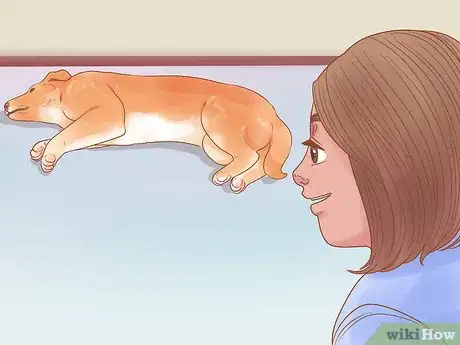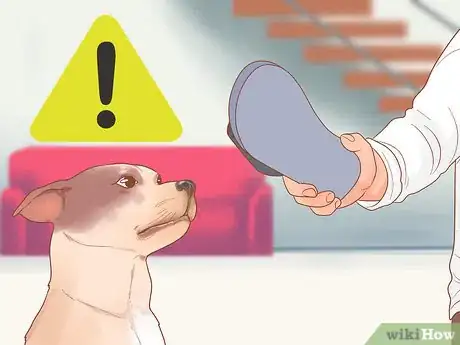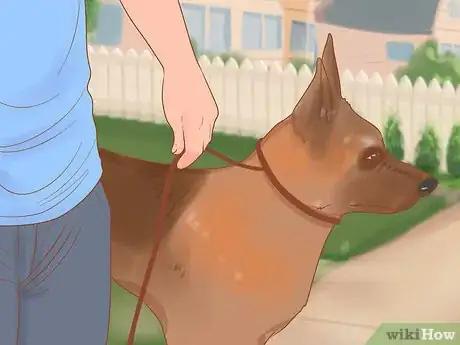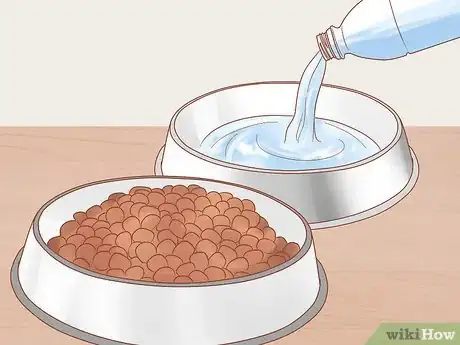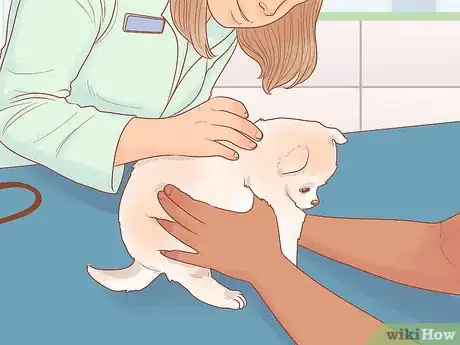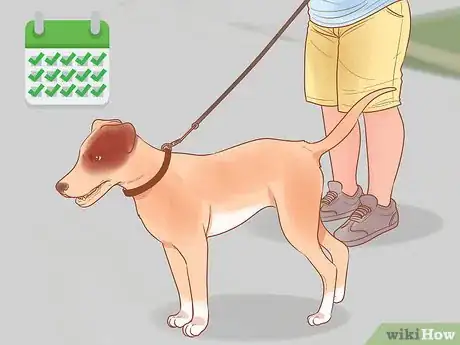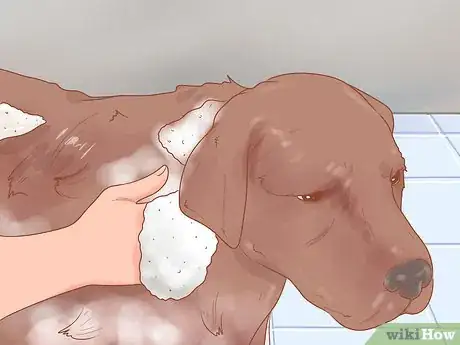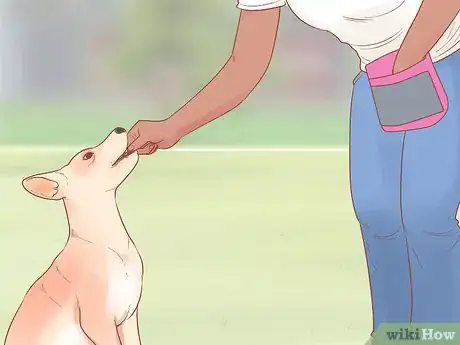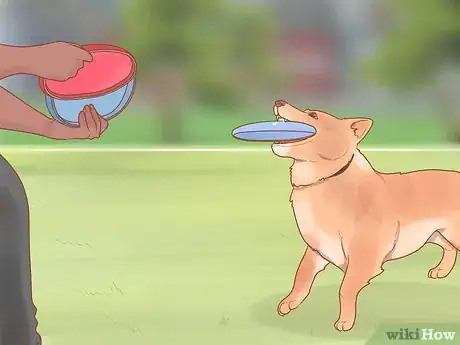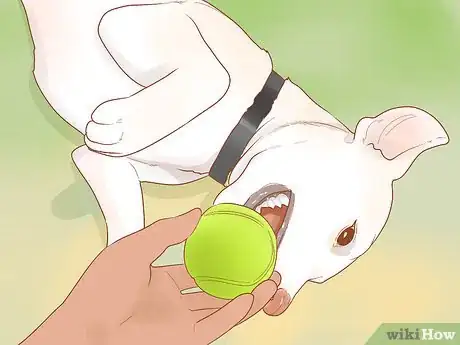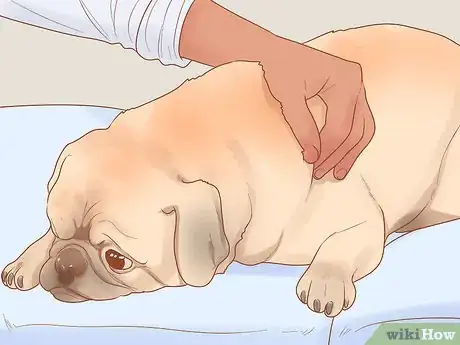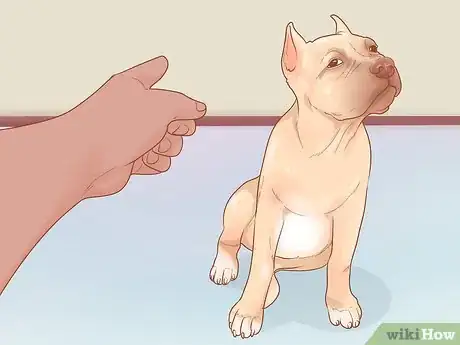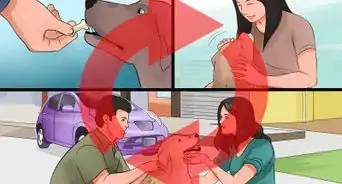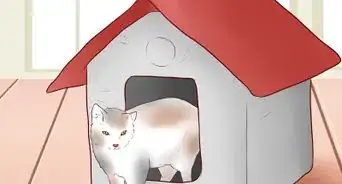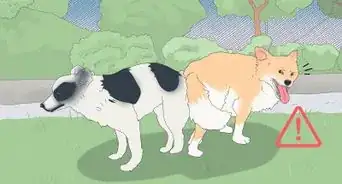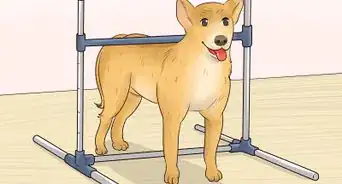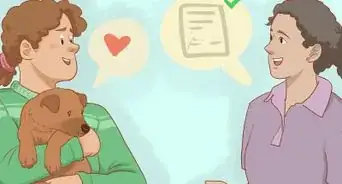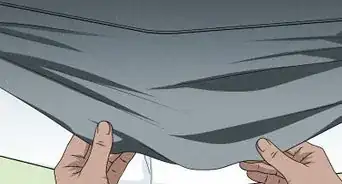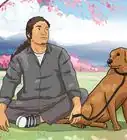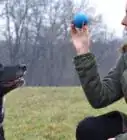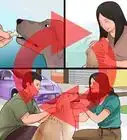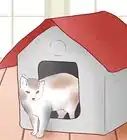This article was co-authored by Ryan Corrigan, LVT, VTS-EVN. Ryan Corrigan is a Licensed Veterinary Technician in California. She received her Bachelor of Science in Veterinary Technology from Purdue University in 2010. She is also a Member of the Academy of Equine Veterinary Nursing Technicians since 2011.
There are 14 references cited in this article, which can be found at the bottom of the page.
This article has been viewed 113,168 times.
Dogs have been bred for centuries to become man’s best friend. When you are attentive, respectful, and care about your dog’s well-being, it is easier to build a stronger bond between the two of you. Having a strong relationship with your dog can be a source of protection, of comfort, and of love for both of you. Strengthen your bond with your dog through respect, attentiveness, and kindness!
Steps
Being Attentive and Observant
-
1Learn your dog's moods and feelings. This requires being observant and learning what you can about your own dog's temperament.[1]
- Use their body language to learn how your dog is feeling and if they are comfortable.
- If you just adopted or purchased this dog, give it some time to adjust to its surroundings before overwhelming it with attention.
- Dogs will try to tell you things that they need and want. They may bring you their favorite toy or a tennis ball if they want to play, or whine by the door if they need to go outside. Paying attention to the cues that your dog gives you will help you to address their needs and wants.
- Some dogs may express themselves with different noises and expressions. Others, however, may be quieter and harder to read.
-
2Pay close attention to your dog’s body language. A dog’s body language can tell you how they are feeling about a situation, their mood, or if they are receptive to other dogs and people in their space.[2]
- Dogs that have relaxed body positions, are enthusiastically wagging their tail or thumping it on the floor, have a happy expression on their face like a smile, and are in a play bow (bowing the front of their body towards the floor with their tail wagging) are happy and receptive to play![3]
- Dogs that are scared or anxious may try to avoid you by backing away from you, turning their head and body away from you, and hiding behind another person or object. Anxious dogs also may have their tail between their legs, and have wide bulging eyes (this is called a half moon eye). [4]
- A dog that is aggressive may growl, guard their favorite possessions, snap at you, snarl, lunge off their leash, and bite.[5]
Advertisement -
3Give your dog space. All animals need down time and to be alone so they can rest. Just like humans, dogs can become overwhelmed, tired, and cranky. If they're tired, they may try to tell you that they'd like to be alone by avoiding you and going to a space they enjoy sleeping in. This doesn't mean that your dog doesn't like you, they just need some time to themselves and to reset.[6]
- Give your dog space when they are tired, seem agitated, or appear to be afraid.
- Make sure that the dog has a private, quiet space where it can retreat if it needs to nap or rest. This could be a crate, a bed in a different room, or a separate couch.
- Once you are able to learn your dog’s body language, you need to respond appropriately to what they are communicating to you.
-
4Respect your dog. Whether you have had this dog for a few weeks or for many years, you should always treat them with respect and love. If you want your dog to become your best friend, you also have to be their best friend. Friendships are built on mutual respect and care; the way that you treat your dog will become the ways that your dog will treat you. When you treat them with care and attention, they will reciprocate in their own way.
- Never harm or hit your dog. This is animal abuse and you should not have a dog if you cannot refrain from hurting them. If you have a dog that you find yourself abusing, immediately surrender the dog to a shelter where they can be well taken care of.[7]
- If you suspect that your dog has been harmed by someone else, you should take them to the veterinarian immediately. Contact law enforcement or your local animal control agency and let them know that your dog has been harmed.[8]
- If your dog does not trust you, it will take time to develop a relationship. Dogs that have been rescued from abusive situations may take a longer time to warm up to you and to feel safe. Be respectful of the fact that they need more time to feel comfortable, and let the relationship progress at a slower pace.
- Some dogs may be startled by noises or fast movements. If you have a new dog in your home, try to move more slowly around it until it relaxes and you learn its triggers.
-
5Keep your dog safe. Your dog's safety can be threatened by things outside and inside of your home. Keeping your dog safe will help them to live a long and healthy life so that you can spend more time together![9]
- Dogs are unable to eat many food items. You should avoid feeding your dog from your table as part of your behavioral training, but be aware that certain foods pose serious health risks to your pet. Some of the more common foods that dogs can never eat include chocolate, avocado, raisins and grapes, fruits with pits, garlic, and onions.[10]
- Always keep your dog on a leash when you take them on a walk. Many cities and states have laws that forbid dogs to be off leash, but it's always a good idea to stay on the leash. Leashing your dog can help keep them away from other dogs that may be aggressive, busy roads and intersections, and the risk that they may run away.
- Pet proof your home. Like babies and small children, dogs are curious creatures that can get into things they shouldn't. Lock away your cleaning products and any medicines. Buy a trashcan that your dog can't open. Move or put away any cords lying on the ground. Use baby gates or lock doors to keep dogs out of rooms they don't belong in.[11]
Keeping Your Dog Happy and Healthy
-
1Feed and give water to your dog. This may seem obvious, but feeding your dog is absolutely essential both to your relationship and the health of your dog.
- The first week your dog is in your home, try feeding it from your hands. This will encourage the dog to trust you.
- Let your dog watch you fill their food and water bowls. They will associate you with food and understand that you are providing for them.
- Feed your dog at specific times during the day rather than leaving food out all day. This is a good way to help your dog build a routine and to further associate you with food and caring for them.
- There are many different types of dog food. Ask your veterinarian for a recommendation if you are unsure of what to choose. Some dogs are pickier than others and prefer certain types of dog food over others. It may take a few tries to find a food that your dog likes.
- Treats are a great way to motivate your dog to do tricks or to reward them for good behavior. Give treats in moderation to keep your dog at a healthy weight.
-
2Take your dog to the veterinarian. A healthy dog is a happy dog! Good preventive medical care helps them live a longer happier life.[12]
- Make sure your dog is up to date on vaccinations and worming.
- If your dog does have medical problems, their medical care can become very expensive. Pet medical insurance is one option to help moderate your costs.[13]
- When you have a strong bond with your dog, your dog will begin to understand that you are concerned about their health and wellbeing when it comes to medical procedures or vet visits.
-
3Walk your dog daily. Your dog will need plenty of exercise to keep healthy and spending time together walking is a good way to bond with your pet. Again, they will associate you with going on walks, which many dogs find to be their favorite activity!
- Purchase a good quality leash. If you have a larger dog that is strong, you may want to consider buying a harness or a head halter to attach to a leash.
- Take your dog out regularly for good long walks.
- Train them to behave appropriately on a leash. They should not be pulling you along the road. They should heel and stay close by your side and walk at your pace.
- Take your dog to the dog park and let them socialize with other dogs and people. Your dog can bond and meet new friends while they enjoy being outside and running free.
- Always clean up after your dog and carry plastic bags on your walks to dispose of your dog’s waste.
- Try taking your dog to new and exciting places on your walks to keep it engaged. For example, you can go to a new park, garden, trail, or downtown street.
-
4Bathe and groom your dog. Depending on the breed of your dog, they may require more frequent or complicated grooming.[14]
- Generally, try to brush your dog’s fur at least once a week to prevent knotted, matted hair.
- Give them baths. Some dogs love baths, some are not such big fans. Wash them at least once a month, or whenever they are muddy or dirty.[15] . If you use a gentle shampoo, you can bathe your dog up to once a week.
- Depending on the breed, you may need to take your dog to the groomers so they can give your dog hair cuts that are appropriate for the breed.
- Trim your dog’s nails. Like humans, dogs’ nails grow continuously. Unless your dog is very active and wears them down on pavement or concrete, you will need to trim their nails when they become long. There are special dog nail clippers, but regular nail clippers can be used as well.
Training and Having Fun
-
1Attend a brief dog training class. If you have never trained a dog before, a dog training class is a helpful way to learn the basics. Obedience classes can also help you and your dog grow closer since you will be working with it one-on-one.
- Training your dog can help keep them safe, healthy, and sociable.
- As the owner, you are the leader and guide in your relationship with your dog. They rely on you for their health and well-being so it is important to set boundaries with your dog in regards to undesirable behaviors.
- Obedience classes help you and your dog to establish good communication when they learn to respect and follow your verbal and physical cues.
-
2Keep all learning a fun experience. When you are training your dog, mix it with play!
- Many dogs, especially working dog breeds, enjoy tasks and are bred to perform jobs. These dogs may benefit from participating in an agility training course, receiving more exercise, and spending more time outdoors.[16]
- Many dogs are motivated by food, so small treats can be a positive motivator when they correctly do a trick or a specific behavior.
-
3Play with your dog. Play encourages a healthy relationship and gives you an opportunity to continue to bond with your dog.
- Games like fetch or tug of war are great ways to give your dog some exercise and for them to have fun. Try different games to see what your dog enjoys.[17]
- Some dogs are less interested in playing with you than others. Some may prefer to play independently or with other dogs. This is okay! This is just your dog’s personal preference and you should respect that.
- Keep track of games and toys that your dog likes better than others! If your dog likes fetch, get toys that can be thrown or tossed, like balls and frisbees. If they prefer puzzles, invest in Kong toys or toys where treats can be hidden inside.
-
4Pet your dog. Physical contact is a great way to show that you care about your pet. Most dogs love belly rubs, pats on the head, and pets. When you pet your dog, studies have shown that both you and your dog release a hormone called oxytocin, which makes you both feel calm and happy.[18]
- Snuggling and cuddling with your dog helps to de-stress both of you, while encouraging a strong physical bond.
- Some dogs like more physical contact than others, and there are times when even the cuddliest dog needs their space. Just like with humans, sometimes dogs want to be close to you and in physical contact, and during other times they don't.
- Physical contact helps to solidify the emotional and relational bond between you and your dog. It demonstrates that you both love, respect, and care for each other.
- Grooming also shows your dog that you care about their wellbeing, and it helps to foster a physical bond while keeping your dog healthy and clean.
-
5Discipline your dog. Disciplining your dog is essential in maintaining good boundaries in your relationship.
- There are different ways to discipline your dog, but you should never hit your dog. If a dog has done something that it shouldn't have, like going on your couch or eating off your plate, you can make them sit and sternly say, "No! Bad dog! Don't do that!"
- If you use a stern voice for disciplining them, they will act submissive because they will know they were bad. What you see as "guilty", a dog sees as sad. Averting the eyes, crouching down low with their head bowed, or giving you that look, shows that they know you are mad at them. While they might know you are mad at them, it is important to give discipline right away, when they are bad. That way, they will know why they are in trouble.
- If you come home to find that they have ripped the couch to shreds, do not discipline them. You didn't catch them in the act, therefore they have no idea what you are yelling at them for. Destructive behavior is a sign of boredom. Let them spend the day outside in your backyard, or perhaps take them for more frequent walks. If you do not want them in the livingroom, or any particular room, consider dog gates.
- Don't use threats that your dog won't understand. For instance, "You ripped up the couch, we are not going to the dog park tomorrow!". Dogs will not understand this and have no idea what you are saying.
- Use discipline that is appropriate for the scenario. The discipline that you would use if your dog barked when it shouldn't have versus tearing up your couch will be very different.
- Avoid using the dog's crate for discipline. The crate should be a safe space for your dog. Only put the dog in there if it is too hyper or wound up.
Expert Q&A
Did you know you can get expert answers for this article?
Unlock expert answers by supporting wikiHow
-
QuestionDoes my dog pee on my furniture because they're mad at me?
 Indigo WillIndigo Will is a Canine Expert, Trainer, and Founder and Owner of K9-INDIGO® Holistic Dog Training LLC™, a dog training service in Los Angeles, California. Indigo specializes in understanding canine temperament and dispositions to allow canines to reach their full potential. He has studied various methods of training and philosophies to develop a unique, innovative, and result-driven method for canine behavior training.
Indigo WillIndigo Will is a Canine Expert, Trainer, and Founder and Owner of K9-INDIGO® Holistic Dog Training LLC™, a dog training service in Los Angeles, California. Indigo specializes in understanding canine temperament and dispositions to allow canines to reach their full potential. He has studied various methods of training and philosophies to develop a unique, innovative, and result-driven method for canine behavior training.
Professional Canine Expert
-
QuestionHow do I bond with my puppy as soon as they come home?
 Indigo WillIndigo Will is a Canine Expert, Trainer, and Founder and Owner of K9-INDIGO® Holistic Dog Training LLC™, a dog training service in Los Angeles, California. Indigo specializes in understanding canine temperament and dispositions to allow canines to reach their full potential. He has studied various methods of training and philosophies to develop a unique, innovative, and result-driven method for canine behavior training.
Indigo WillIndigo Will is a Canine Expert, Trainer, and Founder and Owner of K9-INDIGO® Holistic Dog Training LLC™, a dog training service in Los Angeles, California. Indigo specializes in understanding canine temperament and dispositions to allow canines to reach their full potential. He has studied various methods of training and philosophies to develop a unique, innovative, and result-driven method for canine behavior training.
Professional Canine Expert
-
QuestionI want to be my dog's best friend, yet I am at school for most of the day. What can I do to strengthen our bond?
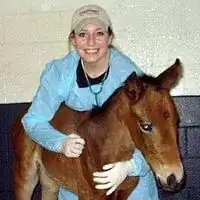 Ryan Corrigan, LVT, VTS-EVNRyan Corrigan is a Licensed Veterinary Technician in California. She received her Bachelor of Science in Veterinary Technology from Purdue University in 2010. She is also a Member of the Academy of Equine Veterinary Nursing Technicians since 2011.
Ryan Corrigan, LVT, VTS-EVNRyan Corrigan is a Licensed Veterinary Technician in California. She received her Bachelor of Science in Veterinary Technology from Purdue University in 2010. She is also a Member of the Academy of Equine Veterinary Nursing Technicians since 2011.
Licensed Veterinary Technician Take your dog for walks before you go to school and play with the dog when you get home. Be the sole provider of food and water for your dog in morning and night. Lastly, if your parents allow it, let your dog sleep in your bed - this will greatly strengthen your bond through both physical touch and quality time.
Take your dog for walks before you go to school and play with the dog when you get home. Be the sole provider of food and water for your dog in morning and night. Lastly, if your parents allow it, let your dog sleep in your bed - this will greatly strengthen your bond through both physical touch and quality time.
Warnings
- If you have small children, train your dog to be more careful around them. Dogs are playful and small children are easily knocked over and injured by a rambunctious dog.⧼thumbs_response⧽
References
- ↑ Indigo Will. Professional Canine Expert. Expert Interview. 8 September 2020.
- ↑ Indigo Will. Professional Canine Expert. Expert Interview. 8 September 2020.
- ↑ http://yourdogsfriend.org/life-with-dogs/learn-to-speak-dog-prevent-bites/signs-of-a-happy-dog/
- ↑ http://yourdogsfriend.org/life-with-dogs/learn-to-speak-dog-prevent-bites/signs-of-anxiety/
- ↑ http://yourdogsfriend.org/life-with-dogs/learn-to-speak-dog-prevent-bites/signs-of-aggression/
- ↑ Indigo Will. Professional Canine Expert. Expert Interview. 8 September 2020.
- ↑ https://www.animalhumanesociety.org/services/surrender-your-pet
- ↑ http://www.humanesociety.org/issues/abuse_neglect/tips/if_your_pet_is_abused.html
- ↑ Indigo Will. Professional Canine Expert. Expert Interview. 8 September 2020.
- ↑ http://pets.webmd.com/dogs/ss/slideshow-foods-your-dog-should-never-eat
- ↑ http://www.petful.com/misc/dog-proof-your-home/
- ↑ Indigo Will. Professional Canine Expert. Expert Interview. 8 September 2020.
- ↑ http://www.petmd.com/blogs/fullyvetted/bspiro/2013/march/the-cost-benefits-of-paying-for-pet-health-insurance-29922
- ↑ http://dogtime.com/dog-breeds/characteristics/more-grooming-required
- ↑ http://www.akc.org/content/dog-care/articles/bathing-puppy-bath-shampoo-care/
- ↑ http://www.akc.org/dog-breeds/groups/working/
- ↑ http://www.dogplay.com/Activities/games.html
- ↑ http://thebark.com/content/9-ways-improve-your-relationship-your-dog
About This Article
Your dog most likely would love to be your best friend, and you can help build that relationship by being attentive and respectful to your pup. Spend time bonding with your dog for at least 15-30 minutes every day. Pay attention to your dog’s body language to learn how they are feeling and know when they’re uncomfortable. Make your dog feel secure by taking care of all of its needs, including giving it fresh food and water every day, providing it with a safe, clean environment, and providing it with medical care. Keep reading to learn tips from our Veterinary co-author on how training can help improve your relationship with your dog!



